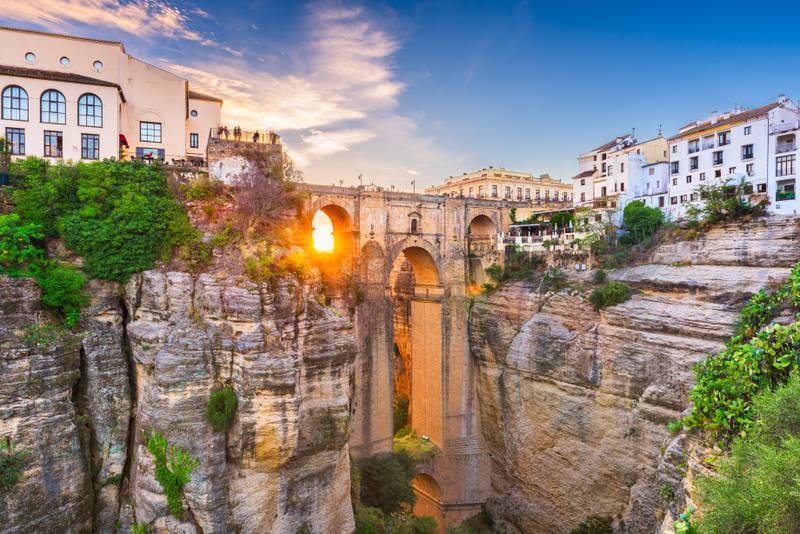A guide to Spain's Costa del Sol as Etihad launches flights to Malaga
11 July, 2021

Running along Spain’s southern Mediterranean coast in the autonomous region of Andalusia, the Costa del Sol consists of 103 towns and villages, and has an ever-changing coastline that includes beaches, cliffs, estuaries, bays and dunes. Formerly home to a series of tiny fishing villages, the area has evolved into a world-renowned tourist destination over the past 60 years.
Who can visit the Costa del Sol?
Spain has reopened its borders to UAE travellers. All vaccinated visitors can enter the country, which recognises the Sinopharm, Pfizer and AstraZeneca vaccines. Travellers must present a vaccination certificate proving that their final dose was administered at least 14 days prior to travel.
Unvaccinated travellers from the UAE are also permitted to enter Spain, provided they present a negative PCR test or proof of recovery from the disease. All visitors are required to fill in a Health Control Form and obtain a QR code that must be presented on arrival in Spain.
Spain is on Abu Dhabi’s Green List, meaning travellers do not need to quarantine upon their return to the UAE capital.
Which airlines fly to the Costa del Sol?
Etihad is launching flights to Malaga on Friday, making the Costa del Sol immediately accessible to UAE travellers. The twice-weekly flights will run on Wednesdays and Fridays until Wednesday, September 15. The outbound service is direct, with a flight time from Abu Dhabi to Malaga of just under eight hours. The return flight includes a one hour 30-minute stopover in Madrid.
The Costa del Sol is also easily reachable from Madrid and Barcelona, and Emirates flies to both Spanish cities.
How safe is Spain?
Almost 50 per cent of Spain’s population has received two vaccine doses and it is expected that 70 per cent of the population will be vaccinated in the next month or so.
At present there are limited restrictions in the country. Restaurants are currently open until midnight and nightclubs until 2am. Face masks must be worn in confined spaces.
What can I see and do in the Costa del Sol?
From glitzy Marbella to party-tastic Torremolinos, history-infused Malaga and a host of charming but lesser-known towns and villages, there is something for everyone in the Costa del Sol. There are endless stretches of beach, plenty of parks, excellent shopping opportunities and Spain’s signature hearty cuisine and hospitality.
“We have an amazing gastronomic offering," says Henrique Oliveira, sales manager of the Puente Romano Beach Resort and Nobu Hotel in Marbella. "In Spain, we spend the day eating. It’s a very social experience. And the prices are amazing for people coming from the UAE.”
Jose Puebla, a member of the Costa del Sol Tourism Forum, says: “Our gastronomy in Spain is very similar to Arab food. That’s important, especially when you are travelling with children. There are also many other links and similarities between our cultures, from the way we talk to our friendliness.”
The Costa del Sol is also safe, tolerant and very used to welcoming travellers from the Middle East.
As recently as the early 1940s, Marbella was still a quiet agricultural town with a population of less than 9,000. Spanish aristocrat Ricardo Soriano, Marquis of Ivanrey, is credited with popularising the town, after he moved there in 1943 and introduced the area to his rich and famous friends.
Soriano’s nephew, Prince Alfonso von Hohenlohe, became so enamoured with Marbella that he converted an old farmhouse into the now famous Marbella Club. By the 1960s, well-known faces had become a regular fixture in the seaside town, from Audrey Hepburn and the Duke and Duchess of Windsor, to Prince Rainier III of Monaco and Grace Kelly, Ava Gardner, Cary Grant, Laurence Olivier and Teddy Kennedy.
Marbella has retained its glitzy appeal. It has long attracted Saudi, UAE and Kuwaiti royalty, and its famous residents include Antonio Banderas, Dolph Lundgren and Lord Alan Sugar of The Apprentice. The area offers 11 golf courses, three marinas and a high concentration of luxury hotels and world-class restaurants.
The town is also home to the King Abdul Aziz Mosque, which was financed by Saudi Arabia in 1981.
Part of its attraction, then and now, lies in the fact that Marbella sits in the shadow of the 1,215-metre high La Concha mountain, which, apart from contributing to the area’s breathtaking views, creates a unique microclimate, giving Marbella some of the best weather in southern Europe.
For modern-day visitors, La Concha offers fantastic hiking opportunities, as well as panoramic vistas of Gibraltar, northern Africa and inland Spain.
Malaga, the capital of the Costa del Sol and birthplace of Pablo Picasso, offers a strong cultural slant, with plenty of museums and cultural institutions dedicated to the artist. The city is also home to 11th century fortresses, an ancient Roman Theatre and stunning examples of Gothic and 19th-century architecture.
“I think what makes Costa del Sol different from other destinations is the culture it offers," says Oliveira. "It’s not just the sea and the sand. If you go inland, you have all these beautiful places with an Arabic influence. The Arabs were there for about 800 years and left an amazing heritage, including the second-most visited monument in Spain, the Alhambra in Granada. So Costa del Sol and Andalusia as a whole are not just about the coast.”
Source: japantoday.com
TAG(s):
